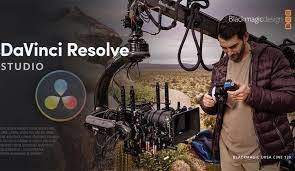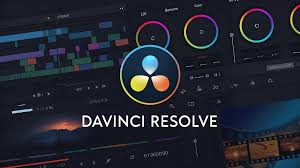Introduction: Why Choose DaVinci Resolve as a Beginner?
If you're new to video editing, DaVinci Resolve might seem intimidating—but don’t let its Hollywood reputation fool you. While it’s used for blockbuster post-production, DaVinci Resolve is also perfect for beginners, especially in 2025. It’s free, feature-rich, and all-in-one, combining video editing, color grading, visual effects, and audio mixing in a single platform.
This guide will walk you through how to use DaVinci Resolve step by step—from importing your first video clip to exporting your final masterpiece. Whether you're editing YouTube videos, short films, or Instagram reels, you’ll learn the essentials without getting overwhelmed.

Step 1: Download and Install DaVinci Resolve
Where to Get It:
Visit the official Blackmagic Design website
Download the free version or purchase DaVinci Resolve Studio (one-time $295) for advanced tools
System Requirements:
RAM: At least 16GB (32GB recommended for Fusion/VFX)
GPU: Discrete graphics card (NVIDIA or AMD)
Storage: SSD for better performance
Once installed, launch the software and create a new project in the Project Manager.
Step 2: Understand DaVinci Resolve's Interface
DaVinci Resolve is divided into "pages", each with a specific role in your editing workflow:
| Page | Function |
|---|---|
| Media | Import and organize media files |
| Cut | Fast, simplified editing (great for social content) |
| Edit | Full-featured timeline editing |
| Fusion | Visual effects and motion graphics |
| Color | Color grading tools (industry-standard) |
| Fairlight | Professional audio editing |
| Deliver | Export your final project |
Step 3: Import Footage into the Media Pool
Go to the Media page
Drag and drop your video, audio, or image files into the Media Pool
Organize your clips into bins (folders)
Alternatively, use File > Import > Media to browse your files.
Step 4: Edit Your Video in the Edit Page
Timeline Basics:
Drag clips from the Media Pool into the timeline
Use the blade tool (B) to cut clips
Use the selection tool (A) to move or trim clips
Add transitions by going to the Effects Library > Video Transitions
Use Inspector (top right) to resize, reposition, or add basic effects
Add Music or Voiceover:
Import your audio files just like video
Drag them onto an audio track in the timeline
Adjust volume and fade with keyframes or handles
Step 5: Enhance with Titles and Effects
Add Titles:
Go to Effects Library > Titles
Drag a title onto the timeline
Customize text, font, and animation in the Inspector
Add Video Effects:
Under OpenFX, drag effects like Glow, Sharpen, or Color Grading Presets onto a clip
Adjust parameters via the Inspector
Step 6: Color Correction (Optional for Beginners)
Go to the Color page
Use Lift/Gamma/Gain wheels to adjust brightness and contrast
Apply LUTs (Look-Up Tables) for fast cinematic looks
Use scopes to balance exposure and color tones (optional)
Don’t worry if this feels advanced—basic color correction isn't mandatory for beginners.
Step 7: Clean Up Audio in Fairlight (Optional)
Use the Fairlight page for noise reduction, EQ, compression, and audio automation
Drag fades in the timeline or add voice isolation if you have the Studio version
Use the Mixer to adjust levels across multiple audio tracks
Step 8: Export Your Video via the Deliver Page
Go to the Deliver page
Choose a preset (YouTube, Vimeo, Custom Export, etc.)
Set resolution, format (MP4, MOV), and codec (H.264 for most web videos)
Choose export location and click Add to Render Queue
Hit Render All
Congrats—your video is ready to share!
Pro Tips for Beginners
Use auto-save: Resolve can crash on heavy projects. Enable frequent auto-saves under Preferences.
Use Cut page for faster edits (e.g., reels, TikTok).
Learn shortcuts: ‘B’ for Blade, ‘A’ for Selection, ‘Ctrl+Z’ for undo.
Stick to MP4 + H.264 for general-purpose exports.
Practice! DaVinci Resolve has a learning curve but rewards you with power and flexibility.
Frequently Asked Questions
Q1: Is DaVinci Resolve good for beginners?
Yes. The Edit and Cut pages are user-friendly, and the free version has all the tools you need to get started.
Q2: Do I need the Studio version to export in HD or 4K?
No. The free version supports 4K UHD exports. Studio is only needed for HDR, advanced AI tools, and 10-bit workflows.
Q3: Can I add music or voiceover in the free version?
Absolutely. You can record voiceovers, add music, and use keyframes—all in the free version.
Q4: What format should I export in for YouTube?
Use the YouTube preset in the Deliver page (MP4 format, H.264 codec, 1080p or 4K).
Q5: How long does it take to learn DaVinci Resolve?
Most beginners become comfortable within 1–2 weeks of regular use. Deeper skills like Fusion or Color Grading can take longer but are worth learning over time.
Final Thoughts: Start Creating with Confidence
DaVinci Resolve might feel overwhelming at first, but with a bit of practice, you’ll realize it’s one of the most beginner-friendly and future-proof editors on the market. You don’t need a subscription. You don’t need a $300 plugin pack. You just need your creativity—and a little guidance.
Whether you're cutting together your first vlog or working on a cinematic short, DaVinci Resolve has all the tools you need to grow your skills from beginner to pro.
Learn more about AI MUSIC

